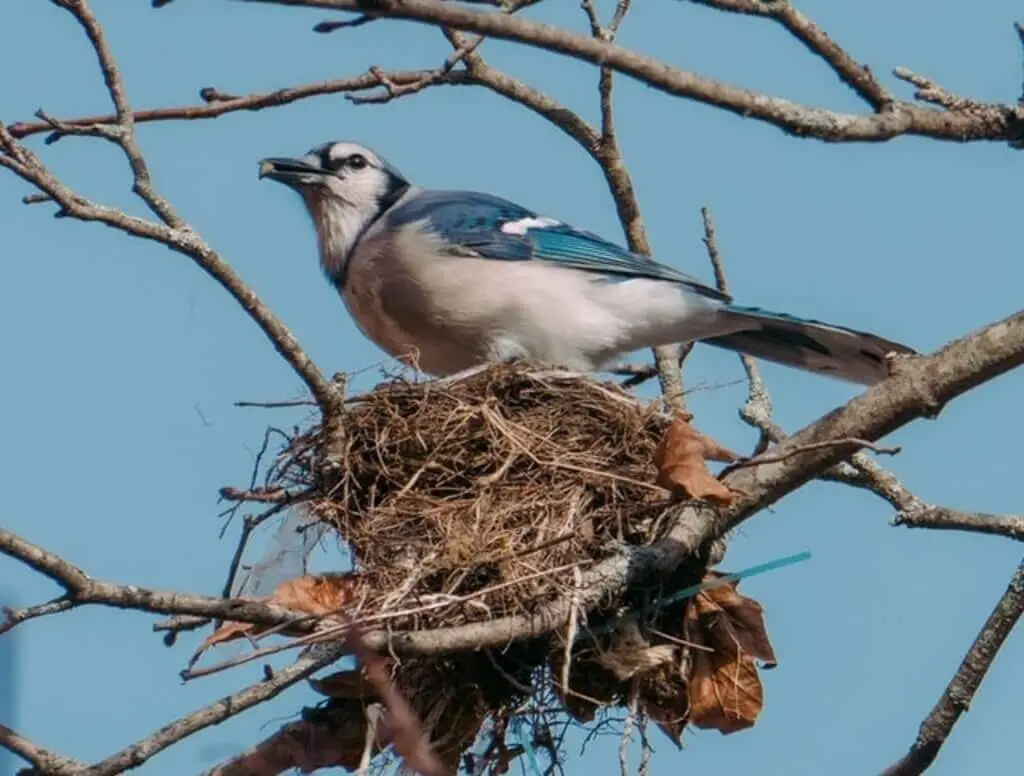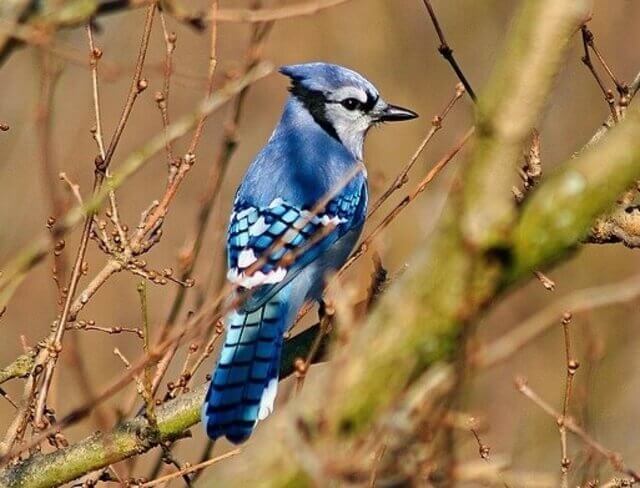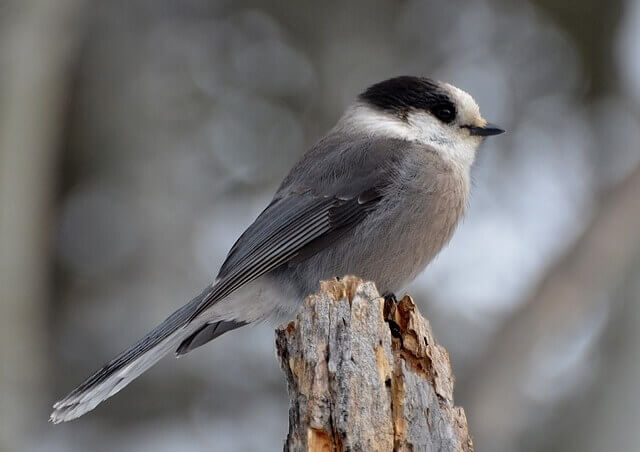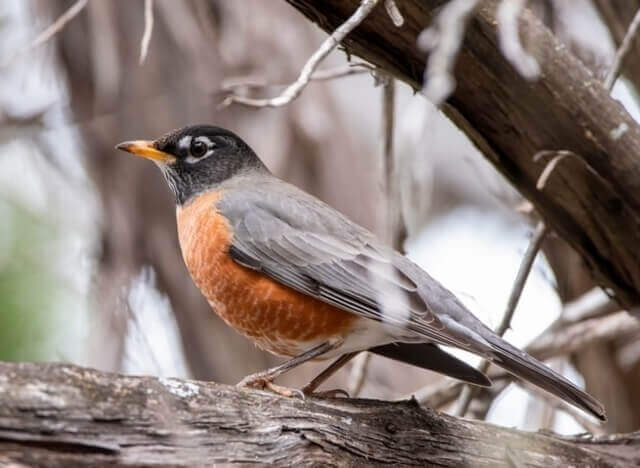The world is full of many mysteries and phenomena that we don’t fully understand. One such mystery is the phenomenon of animals eating other animals’ eggs, a process known as “oophagy”.
In this article, we will provide you with a comprehensive guide to 12 birds that eat other birds eggs. We will provide identification tips, fun facts, and more. So if you’re interested in learning about these fascinating creatures, read on!
Table of Contents
- 1 Key Takeaways
- 2 Types of Birds That Eat Other Birds Eggs
- 3 Nutritional Components of Eggs for Birds
- 4 Reasons Why Birds Occasionally Eat Eggs
- 5 Conclusion
- 6 FAQs
- 6.1 Do blue jays eat other birds?
- 6.2 Do blue jays eat other birds’ eggs?
- 6.3 Do birds eat other birds’ eggs?
- 6.4 What eats bird eggs?
- 6.5 Do robins eat other birds’ eggs?
- 6.6 Do cardinals eat other birds?
- 6.7 Do birds steal other birds’ eggs?
- 6.8 Do blue jays steal eggs?
- 6.9 Do blackbirds eat other birds’ eggs?
- 6.10 Do blackbirds eat other birds’ eggs?
- 6.11 Do cardinals eat other birds’ eggs?
- 6.12 Birds that eat eggs?
- 6.13 Birds that steal other birds’ eggs?
- 6.14 Do robins eat other baby birds?
- 6.15 Do robins eat other birds?
- 6.16 What eats bird eggs in the nest?
- 6.17 Do crows eat other birds?
- 6.18 Do blackbirds steal eggs?
- 6.19 Do mockingbirds eat other birds’ eggs?
- 6.20 Do bluebirds eat other birds’ eggs?
- 6.21 Do cardinals steal other birds’ eggs?
- 6.22 What eats sparrow eggs?
- 6.23 What birds raid nests?
- 7 Author
Key Takeaways
- Several bird species have evolved to include the eggs of other birds in their diet.
- This behavior is often driven by factors such as competition for nesting sites and food sources.
- Understanding which bird species engage in egg-eating behavior can provide insights into their ecological roles.
- These birds play a unique part in the ecosystem and have adapted in fascinating ways to their surroundings.
- Their diverse behaviors and feeding habits highlight the complexity of avian ecology.
Types of Birds That Eat Other Birds Eggs
Red-headed Woodpecker
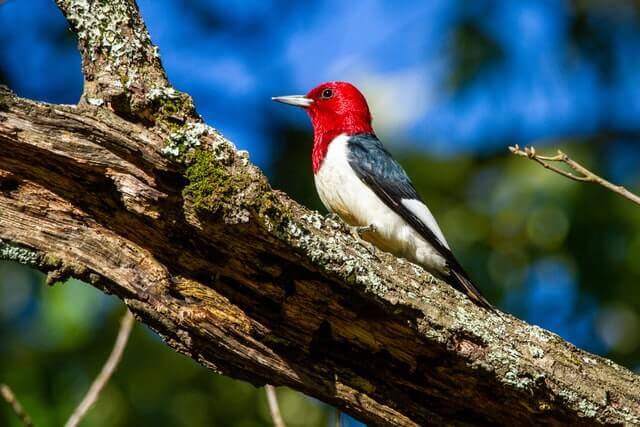
Red-headed Woodpeckers are the most common woodpecker in North America. They are named for their red head and large white patch on their back. These birds usually feed on ants, beetles, crickets, wasps, bees and other insects. But it turns out that they also like to eat eggs of other birds, such as hummingbirds and songbirds, whenever they have the opportunity.
- Length: 7.1-9.4 in (18-24 cm)
- Weight: 1.9-3.2 oz (55-92 g)
- Wingspan: 16.0-16.5 in (40.6-42 cm)
- Range: United States, Canada, Central America, South America.
- Habitat: Wetlands, forests, agricultural land, urban areas,
- Diet: Mainly insects, but they also eat seeds and berries during the winter months.
Red-bellied Woodpecker
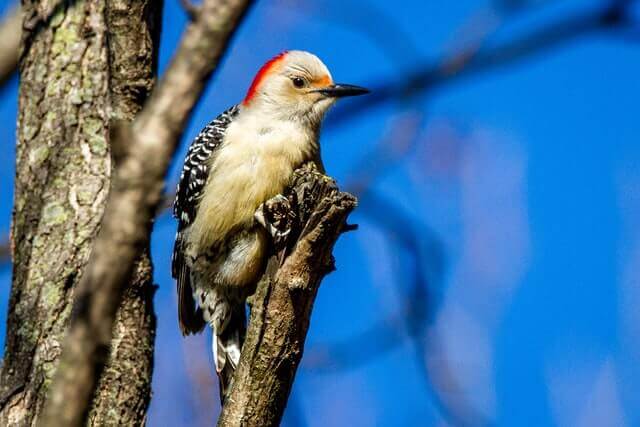
The Red-bellied woodpecker is a common bird in the Eastern United States, with a habitat that includes deciduous forests, pine woods, and swampy areas near water sources. They typically forage on trees or on the ground, looking for insects and larvae to eat as well as small animals, and will occasionally eat birds eggs. This is because they are opportunistic feeders and the eggs are a good source of protein.
- Length: 9.1-10.6 in (23-27 cm)
- Weight: 1.9-3.2 oz (55-91 g)
- Wingspan: 12.6-16.5 in (32-42 cm)
- Range: Southern Canada to Florida and as far west as Texas.
- Habitat: Deciduous forests as well as mixed forests with both hardwoods and conifers.
- Diet: Seeds, insects, spiders, fruits, berries and nectar.
Blue Jay
Blue Jays are one of the species that enjoy eating eggs from other birds, such as American Robins or Northern Cardinals. They find these eggs by using their keen eyesight to spot them while flying overhead or perched in trees. Once they’ve spotted an egg, they’ll swoop down and grab it with their sharp beaks, and swallow it whole.
- Length: 9.8-12.2 in (25-31 cm)
- Weight: 2.5-3.6 oz (70-101 g)
- Wingspan: 13.4-17.3 in (34-44 cm)
- Range: Eastern United States, Canada, Central America, and Northern South America.
- Habitat: Deciduous forests, coniferous forests, and residential areas.
- Diet: Seeds, fruits, insects, worms and snails.
Gray Jay
Gray Jays are scavengers that eat anything, including bird eggs. They are known to take the eggs from other birds nests and then break them open on a branch in order to eat the contents. This is not an uncommon sight at any time of year, but more so during breeding season, when food sources may be scarce for Gray Jays.
- Length: 9.8-13.0″ in (25-33 cm)
- Weight: 65 to 71 g (2.3 to 2.5 oz)
- Wingspan: 17.0-18.5 in (43.2-47.0)
- Range: Found throughout most of Canada and the northern United States.
- Habitat: Coniferous forests, boreal forests, mixed woodlands, deciduous forest edges or clearings, spruce-fir forests.
- Diet: insects, berries, nuts, eggs during summer, switching over to seeds, roots and bulbs during winter months.
American Crow
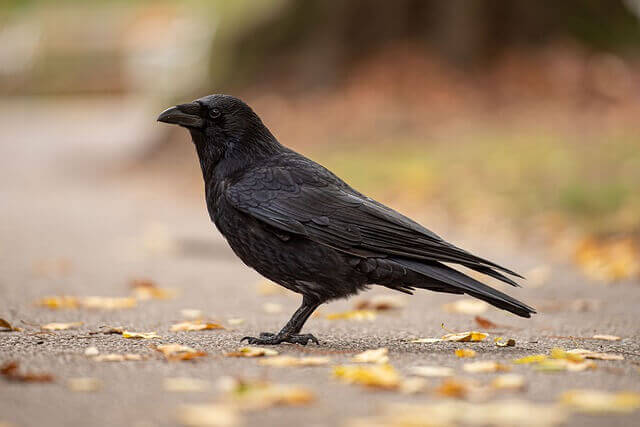
The American Crow is a scavenger and opportunist, which means that they will eat anything. They have been observed eating animals, plants and garbage. In fact, it is not uncommon for them to raid other birds’ nests. This behavior can be seen all over North America. This behavior is called oophagy (o-off-a-gee). They also steal food from other birds when they can get away with it!
- Length: 15.7-21.1 in (40-53.5 cm)
- Weight: 11.1-21.9 oz (315-620 g)
- Wingspan: 33.5-39.8 in (85-101 cm)
- Range: North America, Northern Mexico.
- Habitat: Rural and urban areas.
- Diet: Fruit, nuts, berries, grains and insects.
Common Raven
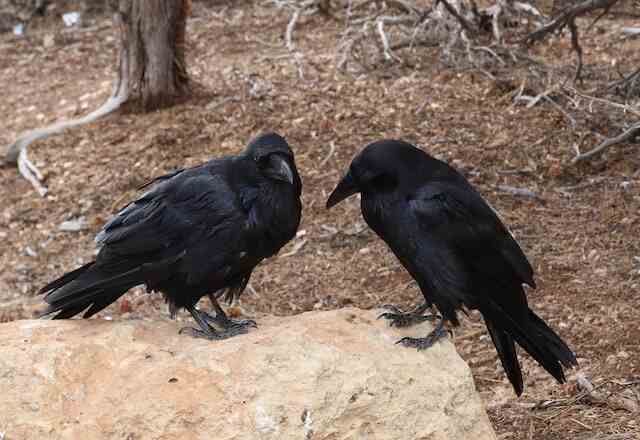
The Common Raven is a black bird that lives in the United States. They are most commonly found near water sources, such as rivers and lakes. One of their favorite foods is bird eggs, which they will usually steal from other birds nests or find by scavenging through the ground for small animals. They can also eat frogs, worms, plants and fruits when needed.
- Length: 21.7-27.6 in (55-70 cm)
- Weight: 24.3-57.4 oz (690-1626 g)
- Wingspan: 45.3-46.9 in (115-119 cm)
- Range: Europe, Asia and North America.
- Habitat: Mountainous regions, forests, or near water sources.
- Diet: Insects, small mammals such as mice, voles and rabbits; other birds eggs including those from gulls or ducks that nest on the ground; carrion (dead animals).
Common Grackle
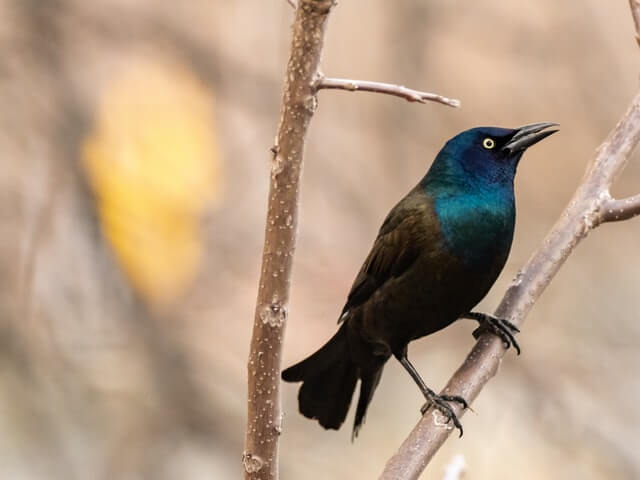
The Common Grackle is a large black bird that frequents the United States. These birds are known for their appetite and aggression, attacking anything from snakes to fish in order to satisfy their hunger. Grackles have been observed eating live turtles, frogs, salamanders, crayfish and even small mammals such as mice. They also prey on smaller birds when they come across them, which has led to an increasing population of grackles throughout the country.
- Length: 11.0-13.8 in (28-35 cm)
- Weight: 2.7-5.0 oz (75-143 g)
- Wingspan: 13.8-18.1 in (35-46 cm)
- Range: North America, Central America, South America, and into southern Canada.
- Habitat: Woodlands, grasslands, wetlands, forests, and even deserts.
- Diet: Insects like beetles and caterpillars but also fruits or berries.
Brown-Headed Cowbird
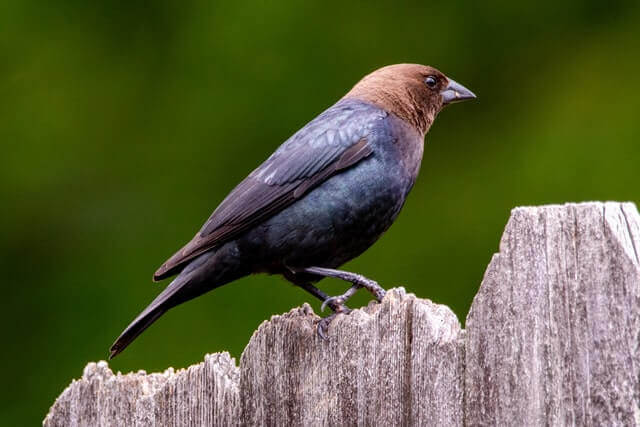
The Brown-headed Cowbird is a small songbird that breeds across North America and South America. It has an appetite for eggs, specifically the eggs of other birds. In fact, cowbirds are considered to be one of the most significant nest predators in North America because they will destroy about fifty percent of all nests they find. This can lead to population declines in some species that rely on nesting habitats like those found in woodlands or shrub lands.
- Length: 7.1-9.1 in (18-23 cm)
- Weight: 1.5-1.8 oz (41-51 g)
- Wingspan: 14.0-14.2 in (25.6-36.1 cm)
- Range: Central Canada to Florida and Mexico, Central America south to Colombia and Ecuador.
- Habitat: Open habitats such as meadows, prairies, pastures, agricultural fields and suburbs.
- Diet: Insects, fruit, berries and seeds.
Black-Capped Chickadee
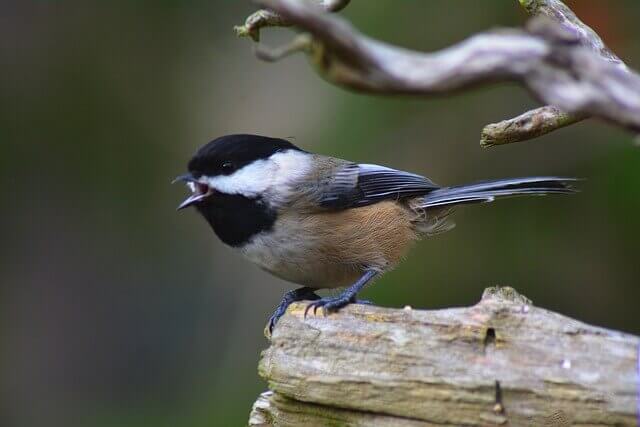
The Black-capped Chickadees are a migratory bird that are found all over North America. These birds also seem to have a taste for bird eggs; in the springtime, they will often raid nests of other species to steal their eggs or young chicks. The Black-capped Chickadees enjoy feasting on anything from bluebird eggs to robin eggs when given the opportunity.
- Length: 4.3-5.9 in (11-15 cm)
- Weight: 0.3-0.5 oz (9-15 g)
- Wingspan: 5.9-8.7 in (15-22 cm)
- Range: Woodlands, shrublands, open country, farmland and suburban areas.
- Habitat: Southern Canada to Northern Mexico.
- Diet: Insects, seeds, nuts and berries during different seasons.
American Robin
American Robins are native to North America and have the widest distribution of any bird in the United States. They eat a variety of foods, including insects, spiders, worms, berries and fruit. One interesting habit is that they will steal eggs from other birds’ nests, as well as scavenge for them on the ground. They will steal from other robin nests and crows’ nests as well.
- Length: 8.3-11.2 in (21-28.5 cm)
- Weight: 2.8-3.0 oz (78-86 g)
- Wingspan: 11.8-15.7 in (30-40 cm)
- Range: North-eastern United States to southern Canada and south to Central America.
- Habitat: Open woodlands, suburbs, parks, agricultural fields and brushy hillsides with scattered trees.
- Diet: Mainly insects, berries and other fruit.
Northern Mockingbird
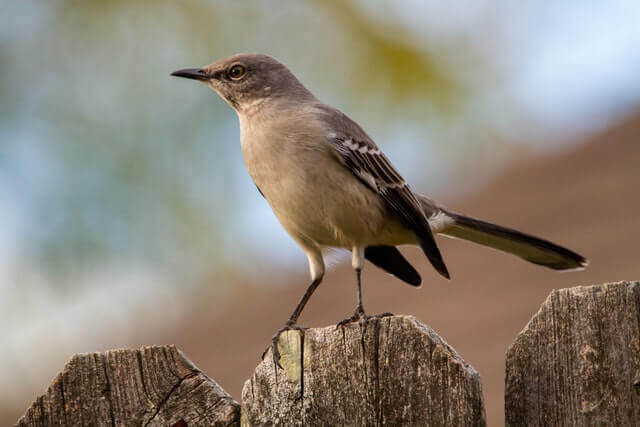
The Northern Mockingbird is a medium-sized bird found in North America. They are omnivores, meaning they eat both plants and animals. They primarily eat fruit, insects, eggs of other birds and small reptiles such as lizards or snakes. It is not common for them to do this, but they have been seen doing it. The reason why Northern Mockingbirds eat other bird’s eggs could be because of a shortage of food in the area.
- Length: 8.1-10.4 in (20.5-26.5 cm)
- Weight: 1.6-2.0 oz (45-59 g)
- Wingspan: 11.8-14.2 in (30-36 cm)
- Range: Eastern United States, Southern Canada, Mexico, and Central America.
- Habitat: Parks, yards, and rural areas.
- Diet: Insects, fruit and seeds.
Carolina Wren
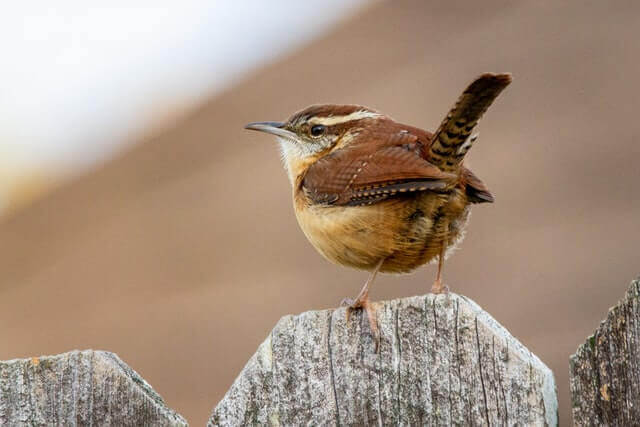
Carolina Wrens will eat other birds’ eggs, especially chickadees. The Carolina wren is an opportunistic bird that feeds on insects and other small animals, as well as a variety of plant material. They are not fussy eaters, so they will feed on the eggs of any species that have been left unattended in their territory or nest site. They have a distinctive foraging style that involves climbing up to the nest and then puncturing the egg, and accessing the insides.
- Length: 4.3-5.7 in (11-14.5 cm)
- Weight: 0.6-0.8 oz (17-23 g)
- Wingspan: 11.0-11.4 in (28-29 cm)
- Range: Eastern North America, South-eastern United States, Southern Canada, and Mexico.
- Habitat: Brushy areas like forests, thickets, hedges along field edges, shrubs, urban areas.
- Diet: Insects, spiders, berries and other fruit.
Nutritional Components of Eggs for Birds
As the world’s foremost ornithologist, I am delighted to shed light on the intricate nutritional aspects of eggs for avian species. Eggs, in the context of bird diets, offer a rich source of essential nutrients, vital for the survival, growth, and reproduction of various bird species.
Protein Content: Eggs are renowned for their high-quality protein content, a fundamental dietary component for birds. Protein is crucial for muscle development, feather formation, and overall physiological well-being. Young birds, in particular, rely heavily on this protein source during their rapid growth phases.
Lipids and Energy: The yolk of bird eggs is rich in lipids, serving as an efficient energy source. Lipids are essential for maintaining a bird’s energy levels during nesting and incubation periods, which require significant endurance and vigilance. Furthermore, lipids contribute to the development of strong and insulating feathers.
Calcium and Phosphorus: Bird eggs contain significant levels of calcium and phosphorus, essential for strong bone formation. These minerals are particularly important for avian species engaged in the egg-laying process. The mother bird requires sufficient calcium to produce eggshells, which are primarily composed of calcium carbonate.
Vitamins: Eggs are a valuable source of essential vitamins, including A, D, E, and various B vitamins. These vitamins play a critical role in maintaining a bird’s overall health and reproductive success. Vitamin D, for example, is necessary for calcium absorption and proper bone development.
Carotenoids: Some bird species consume eggs for their carotenoid content. Carotenoids are responsible for the vibrant colors seen in the feathers of certain birds. These compounds are acquired through the diet and are crucial for visual displays and mate attraction.
Reasons Why Birds Occasionally Eat Eggs
The behavior of birds occasionally eating the eggs of other birds is a fascinating and multifaceted aspect of avian ecology. As the preeminent ornithologist, I can provide insight into the various reasons behind this behavior:
Competition for Resources: In environments where nesting sites and food sources are limited, some bird species resort to consuming eggs as a survival strategy. This can be a consequence of fierce competition for resources within a specific habitat.
Nutritional Supplements: As previously discussed, eggs are a nutritional treasure trove for birds. In times of scarcity or when essential nutrients are lacking in their diet, birds may turn to eggs as a supplementary source of vital proteins, lipids, and minerals.
Territorial Defense: Consumption of the eggs of neighboring birds may serve as a territorial display, discouraging intruders from encroaching on a bird’s nesting area. This can be a means of asserting dominance and protecting valuable resources.
Opportunistic Predation: Birds that occasionally eat eggs are often opportunistic predators. They seize the chance to consume eggs when the opportunity arises, whether it’s a result of foraging behavior or when they encounter unguarded nests.
Innate Behavior: In some cases, the consumption of eggs is an innate behavior, passed down through generations. It may have evolutionary significance, promoting the survival of certain bird species under specific ecological pressures.
These insights into the nutritional value of eggs and the reasons behind egg consumption provide a deeper understanding of the complex world of avian biology and behavior.
Bird species have evolved unique strategies for survival and adaptation, making them a constant source of intrigue and discovery for ornithologists and bird enthusiasts alike.
Conclusion
In conclusion, the occasional consumption of eggs by certain bird species is a complex and intriguing aspect of avian behavior. Whether driven by competition for resources, opportunistic predation, or innate instincts, this behavior highlights the remarkable adaptability of birds in their quest for survival.
As we delve into the nutritional value of eggs and the reasons behind their consumption, we gain a deeper appreciation of the dynamic and multifaceted world of avian ecology.
FAQs
Do blue jays eat other birds?
Yes, blue jays are omnivorous and may occasionally prey on small birds, particularly their nestlings, but this behavior is not their primary diet. They primarily feed on acorns, nuts, and insects.
Do blue jays eat other birds’ eggs?
Yes, blue jays are known to consume the eggs of other birds, especially when they find unattended nests. They can raid nests and devour both eggs and nestlings.
Do birds eat other birds’ eggs?
Yes, some bird species, like blue jays and crows, do eat the eggs of other birds when they have the opportunity. This behavior often occurs during the breeding season when eggs are more accessible.
What eats bird eggs?
Various animals, including birds like blue jays, snakes, raccoons, and mammals, may consume bird eggs when they come across them. Eggs are a source of protein and nutrients for many animals.
Do robins eat other birds’ eggs?
Robins are primarily insectivores and do not commonly eat other birds’ eggs. Their diet mainly consists of worms, insects, and fruits.
Do cardinals eat other birds?
Cardinals do not typically prey on other birds. Their diet mainly consists of seeds and insects, and they are not known for attacking or consuming other bird species.
Do birds steal other birds’ eggs?
Yes, some birds are known to steal and eat the eggs of other bird species. This behavior can be driven by the availability of food and the ease of access to nests.
Do blue jays steal eggs?
Yes, blue jays are known to steal and consume the eggs of other birds when the opportunity arises. They are opportunistic feeders and will take advantage of unguarded nests.
Do blackbirds eat other birds’ eggs?
Blackbirds may occasionally eat the eggs of other birds, especially if they come across unattended nests. This behavior is more likely during times when food is scarce.
Do blackbirds eat other birds’ eggs?
Blackbirds are known to eat the eggs of other birds, particularly when they find unprotected nests. This opportunistic feeding behavior can help supplement their diet.
Do cardinals eat other birds’ eggs?
Cardinals are not typically known for consuming the eggs of other bird species. They have a diet primarily focused on plant material and insects.
Birds that eat eggs?
Several bird species, such as blue jays, crows, and blackbirds, are known to eat the eggs of other birds. This behavior is more common among omnivorous and opportunistic feeders.
Birds that steal other birds’ eggs?
Certain birds, including brown-headed cowbirds, are notorious for laying their eggs in the nests of other bird species, a behavior known as brood parasitism. This is a form of egg stealing where they lay their eggs in the nests of other birds.
Do robins eat other baby birds?
Robins are not known for preying on other birds’ nestlings or baby birds. They mainly feed on insects, worms, and fruits.
Do robins eat other birds?
Robins primarily feed on insects, worms, and fruits and do not commonly eat other birds. Their diet is not focused on other bird species.
What eats bird eggs in the nest?
Animals such as snakes, raccoons, and some bird species like blue jays are known to consume bird eggs when they find them in nests. These animals are opportunistic egg predators.
Do crows eat other birds?
Crows may occasionally eat other birds, particularly their young or nestlings. However, crows have a diverse diet that includes various food sources beyond just other birds.
Do blackbirds steal eggs?
Blackbirds may steal and eat the eggs of other birds when the opportunity arises, especially when they can access unguarded nests.
Do mockingbirds eat other birds’ eggs?
Mockingbirds are not typically known for eating the eggs of other bird species. Their diet mainly consists of insects and fruits.
Do bluebirds eat other birds’ eggs?
Bluebirds are not commonly known for consuming the eggs of other birds. They typically eat insects and berries.
Do cardinals steal other birds’ eggs?
Cardinals do not usually steal the eggs of other birds. They have a different diet primarily focused on seeds, fruits, and insects.
What eats sparrow eggs?
Various predators, including snakes and some bird species, may consume sparrow eggs when given the chance. Sparrow eggs can be a source of food for various animals.
What birds raid nests?
Some bird species, like brown-headed cowbirds, are known for raiding the nests of other birds. They do so either to lay their own eggs in those nests or to steal resources from the nests.

